8 Certified Android EMM Providers & How-to
Android EMM (Enterprise Mobility Management) is a comprehensive set of tools and policies used by organizations to securely manage Android devices, applications, and corporate data. It enables IT administrators to enforce security configurations, deploy and manage work apps, and protect sensitive information on both company-owned and employee-owned (BYOD) Android devices.
This all-inclusive guide will help you understand what an Enterprise Mobility Management system is, why you need it, what are the best EMM providers, and how you can get the best out of it for your business.
- Part 1: What Is Android EMM?
- Part 2: How does Android EMM Work?
- Key Features of Android EMM
- How does Android EMM Secure Corporate Data?
- What is Android Enterprise Recommended Certification?
- Part 3: 8 Certified Android EMM Providers
- Part 4: Factors to Consider When Selecting an EMM Provider
- Part 5: How to Set up Android EMM For Your Business?
- Part 6: Why do Businesses Apply Enterprise Mobility Management Android?
- Part 7: FAQs
1What Is Android EMM?
Android EMM refers to the solutions that empower organizations to securely manage a wide array of Android devices used for work—from company-owned assets to employee-owned (BYOD) and corporate-owned, personally enabled (COPE) devices. Leveraging Android Enterprise, Google's framework for businesses, EMM provides IT teams with centralized control over work applications, corporate data, and device configurations.
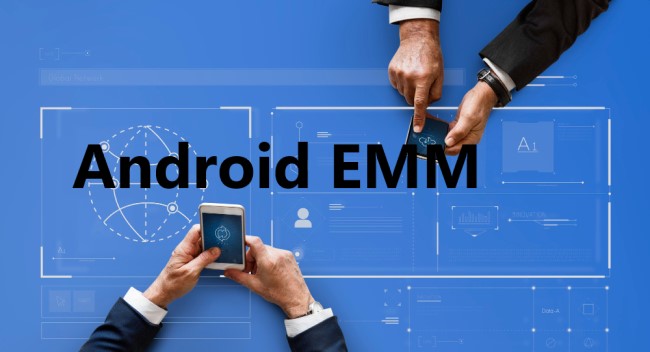
When it comes to the types of devices supported, Android EMM is incredibly versatile, adapting to various operational needs:
Scope of Devices Supported by EMM
Smartphones: Popular Android devices like Google Pixel, Samsung Galaxy series, OnePlus, etc.
Tablets: From Samsung Galaxy Tab series to Lenovo Tab series and other Android tablets.
Chromebooks: Many Chromebooks support Android apps and can be managed for app deployment and policy enforcement.
Android TVs: Smart TVs running Android, useful for centralized app and settings management in hospitality or digital signage.
Rugged Devices & Handheld Terminals: Industrial tablets and scanners from brands like Zebra, Datalogic, and Chainway, crucial for demanding sectors such as logistics and manufacturing.
IoT Devices: Android-powered smart kiosks, POS systems, and vending machines can be integrated for configuration, app management, and security.

Source: android.com
2How does Android EMM Work?
Android EMM goes beyond simply securing devices, it provides a unified control point to manage and streamline your organization's mobile workflow. It achieves this by overseeing not just the devices themselves, but also their entire contents—including apps, connections, networks, and critical data.
This comprehensive control is made possible through the integration of four core components within any robust mobility suite: Mobile Device Management (MDM), Mobile Application Management (MAM), Mobile Content Management (MCM), and Identity and Access Management (IAM). Each of these elements plays a vital role in enabling EMM to protect corporate assets, enhance productivity, and ensure secure access across all enrolled devices.
Key Features of Android EMM
| Component/Element | Definition | Key Features/Scope |
|---|---|---|
| MDM (Mobile Device Management) | Manages and secures devices from a central console by enforcing organizational policies. |
|
| MAM (Mobile Application Management) | Manages and monitors specific applications, not the entire device. |
|
| MCM (Mobile Content Management) | Controls which apps can share specific data, enabling secure content distribution. |
|
| Identity and Access Management | Governs who can access specific data and resources, providing granular control. |
|
How does Android EMM Secure Corporate Data?
The Android EMM, as explained above, is a combination of four elements. MAM, MDM, MCM, and IAM. All these four mobility suites are centered around the concept of protecting the device and its contents against unauthorized access and ensuring the security of the device and data.
This is done by providing the organization with comprehensive control. For example,
- Using Identity and Access Management, the organization can control who gets access to a device or to specific content. Organizations can grant or restrict permissions. This is done using features like Single Sign On and Multifactor Authentication.
- Similarly, Mobile Content Management helps the admin decide which apps can be used to share data and which ones are restricted, hence securing the company’s data against unauthorized sharing.
- EMM also allows the use of KIOSK mode to manage apps on a device. You can even go for a company-specific app on a device and the data will be shared using that app only.
- Device’s security is ensured by using measures like geofencing, device lock, and erasing data remotely if the device is lost or stolen.

Now that you know what Android EMM is all about, which are the best Android EMM solutions to help secure and manage devices for your business? Here are some.
What is Android Enterprise Recommended Certification?
Android Enterprise Recommended is a Google program that certifies enterprise solutions, including EMM providers, for meeting high standards of performance, consistency, and security. This validation ensures that certified EMM solutions offer a predictable deployment experience, comprehensive features, ongoing security updates, and expert technical support, giving businesses confidence in managing their Android fleet.
38 Certified Android EMM Providers
We will introduce two main categories of EMM providers: Large-scale Comprehensive EMM Providers and Android-focused and Specialized EMM Providers. These two types of providers are suitable for businesses of different sizes and with specific requirements.
Large-scale Comprehensive EMM Providers
These providers, typically from major technology companies, offer comprehensive Unified Endpoint Management (UEM) across diverse operating systems (Android, iOS, Windows, macOS, etc.). They are designed for large enterprises with complex IT environments, demanding high scalability, seamless integration, and strict security and compliance. These solutions are suitable for enterprises requiring cross-platform unified management and high security.
1. Microsoft Intune
Best for: Large enterprises prioritizing deep integration with the Microsoft ecosystem
A leading cloud-based Unified Endpoint Management (UEM) tool, highly recognized by Gartner, that offers deep integration with the Microsoft ecosystem. It excels at protecting and managing company-owned and employee-owned devices, making it ideal for large enterprises operating within a Microsoft-centric IT environment.
| Specification | Description |
|---|---|
| Standout Features |
|
| Official Website | https://www.microsoft.com/en-us/security/business/endpoint-management/microsoft-intune |
| Pricing | $10.60 - 16.40 per user/month, 30-day free trial |
| Supported Deployment Method | Cloud-based, on-premises |
| Supported Android OS Version | Android 8.0 and later |
| Supported Endpoints | Phones, tablets, Android Open Source Project (AOSP) devices |
| Pros |
|
| Cons | Sometimes creating new configurations requires lots of testing which makes it a little time-consuming |
| Simplified How-to |
|
| Use Case | Endpoint management, mobile productivity, Identity driven security. |
| G2 Score | 4.5 out of 5 |
2. ManageEngine Mobile Device Manager Plus
Best for: Enterprises needing flexible deployment options and robust application management capabilities
If you want your employees to work across multiple devices without compromising efficiency, productivity, and security, ManageEngine Mobile Device Manager Plus is one of the best EMM solutions you can use freely. It supports on-premises and cloud deployment types which gives more flexibility for COPE and BYOD.
| Specification | Description |
|---|---|
| Standout Features |
|
| Official Website | https://www.manageengine.com/mobile-device-management/ |
| Pricing | $0 for 25 devices/year, $495-895 for 50 devices/year, 30-day free trial |
| Supported Deployment Method | Cloud, On-premises |
| Supported Android OS Version | Android 4.1 and above |
| Supported Endpoints | Phones, tablets, TVs, kiosks, rugged devices, IoT devices |
| Pros |
|
| Cons | Sometimes the test group cannot be updated and the update is pushed to all mobile devices & Lopping Auto deployment not working |
| Simplified How-to |
|
| Use Case | Mobile device management, app management, mobile device security, email management. |
| G2 Score | 4.5 out of 5 |
3. IBM Security Maas360 with Watson
Best for: Enterprises requiring advanced data analytics and intelligent endpoint management
An Android Enterprise Recommended EMM provider, validated by Google, IBM Security Maas360 with Watson specializes in advanced data analytics and intelligent endpoint management. This efficient solution offers comprehensive security and smart control across various operating systems, including Android, Apple OS, Windows, and Kindle Fire devices, ideal for enterprises seeking deep insights and intelligent management of their mobile fleet.
| Specification | Description |
|---|---|
| Standout Features |
|
| Official Website | https://www.ibm.com/products/maas360 |
| Pricing | $4 - 9 per device/month, 30-day free trial |
| Supported Deployment Method | Cloud |
| Supported Android OS Version | Android 2.2 to 12.x |
| Supported Endpoints | Phones, tablets, rugged devices |
| Pros |
|
| Cons |
|
| Simplified How-to |
|
| Use Case | Data analytics, device management, app management, endpoint management, threat management |
| G2 Score | 4.1 out of 5 |
4. Ivanti Neurons for UEM
Best for: Large enterprises prioritizing advanced automation, robust security, and unified management of diverse endpoints
As a comprehensive Unified Endpoint Management (UEM) platform recognized for its hyper-automation and self-healing capabilities, Ivanti Neurons for UEM helps enterprises manage and secure a diverse range of endpoints, including Android, iOS, Windows, and macOS. It is ideal for organizations looking to automate IT operations, enhance security, and ensure compliance across a distributed "everywhere workplace."
| Specification | Description |
|---|---|
| Standout Features |
|
| Official Website | https://www.ivanti.com/products/neurons-for-uem |
| Pricing | Contact sales for pricing; typically quote-based for enterprise solutions. |
| Supported Deployment Method | Cloud, On-premises, Hybrid |
| Supported Android OS Version | Android 5.0 and later (Android Enterprise features fully supported on compatible versions, e.g., Android 9+ for AMAPI in Dedicated mode) |
| Supported Endpoints | Phones, tablets, ruggedized devices, desktops (Windows, macOS), wearables, IoT devices |
| Pros |
|
| Cons |
|
| Simplified How-to |
|
| Use Case | Comprehensive endpoint management and security, IT asset discovery and lifecycle management, automated patch and vulnerability management, secure access for remote workforces. |
| G2 Score | 4.2 out of 5 |
Android-focused and Specialized EMM Providers
These solutions might be more tailored for Android ecosystems, or designed for small to medium-sized businesses (SMBs), or offer specific features (e.g., Kiosk mode, remote control), or cater to niche requirements (e.g., Samsung-only devices). They often provide more competitive pricing or easier setup to suit their target audience. These emm providers are suitable for small to medium-sized businesses needing cost-effective and easy-to-use Android device management.
1. Airdroid Business
Best for: SMBs requiring comprehensive yet easy-to-use Android device management across various device types
AirDroid Business is a leading Android EMM solution, ideal for SMBs seeking to efficiently manage diverse Android devices. Its user-friendly interface simplifies deployment, monitoring, and support. Excelling in dedicated device management scenarios like kiosks, POS systems, and digital signage, it offers robust features such as Kiosk Mode, comprehensive app management, and secure remote control, ultimately enhancing mobile productivity and data security.
| Specification | Description |
|---|---|
| Standout Features |
|
| Official Website | https://www.airdroid.com/business/ |
| Pricing | $12-33 per device/year, 14-day free trial. |
| Supported Deployment Method | Cloud, On-premises |
| Supported Android OS Version | Android 4.1 and later |
| Supported Endpoints | Mobile phone, tablet, rugged device, custom device, POS, Kiosk, smart TV, digital signage. |
| Pros |
|
| Cons | Although they do offer a free trial, it does not give access to all features, e.g., for advanced features like Kiosk and Policy, you will need to buy the full version. |
| Simplified How-to |
|
| Use Case | Endpoint management, mobile productivity, Identity driven security. |
| G2 Score | 4.8 out of 5 |
2. 42Gears Mobility Systems
Best for: SMBs seeking an affordable and straightforward Android device management solution with easy deployment
42Gears Mobility Systems is a highly regarded Android Enterprise EMM provider specifically designed for small to medium-sized businesses. It stands out as an easy-to-use and affordable solution that streamlines device management and deployment. By offering straightforward controls and essential features, it enables SMBs to efficiently secure, monitor, and manage their Android fleet without the complexity often associated with larger enterprise solutions.
| Specification | Description |
|---|---|
| Standout Features |
|
| Official Website | https://www.42gears.com/ |
| Pricing | $3.99-7.99 per device/month, 30-day free trial |
| Supported Deployment Method | Cloud, On-premises |
| Supported Android OS Version | Android 5.0 or higher |
| Supported Endpoints | Phones, tablets, rugged devices |
| Pros | It is among the simplest solutions that provide ease-of-use because of its well-designed interface and seamless controls. |
| Cons | Low performance speed and delays are common problems reported by users. |
| Simplified How-to |
|
| Use Case | Unified Endpoint Management, remote monitoring. |
| G2 Score | 4.8 out of 5 |
3. Knox Manage
Best for: Businesses exclusively using Samsung devices and requiring enhanced security and simplified app management
Knox Manage is a cloud-based Android EMM platform designed exclusively for Samsung devices. Leveraging Samsung's native Knox security features, it offers impeccable device security and streamlined management capabilities. This platform is ideal for businesses that solely utilize Samsung devices, providing enhanced security, simplified app deployment, and efficient control tailored to the Samsung ecosystem.
| Specification | Description |
|---|---|
| Standout Features |
|
| Official Website | https://www.samsungknox.com/en/solutions/it-solutions/knox-manage |
| Pricing | $0 for Samsung devices, 90-day free trial for Knox license |
| Supported Deployment Method | Cloud |
| Supported Version | Knox 2.6 or higher |
| Supported Endpoints | Samsung smartphones and tablets. |
| Pros |
|
| Cons |
|
| Simplified How-to |
|
| Use Case | File transfer, remote management, app management, and geofencing. |
| Google Play Store Rating | 3.4 out of 5 |
4. Scalefusion
Best for: SMBs and enterprises requiring robust Android Enterprise management, especially for dedicated devices, Kiosk mode, and comprehensive application/content control
Scalefusion is a comprehensive Unified Endpoint Management (UEM) solution primarily focused on Android Enterprise, enabling businesses to secure, manage, and monitor their diverse fleet of Android devices. It is well-regarded for its user-friendly interface, powerful Kiosk Mode, and straightforward deployment, making it an excellent choice for businesses of all sizes, especially those with dedicated device fleets.
| Specification | Description |
|---|---|
| Standout Features |
|
| Official Website | https://scalefusion.com/ |
| Pricing | Starts from $2/device/month (billed annually); free trial available |
| Supported Deployment Method | Cloud |
| Supported Android OS Version | Android 6.0 and later |
| Supported Endpoints | Phones, tablets, rugged devices, POS, kiosks, digital signage. |
| Pros |
|
| Cons |
|
| Simplified How-to |
|
| Use Case | Android Enterprise management, Kiosk mode, dedicated device management, application and content control. |
| G2 Score | 4.7 out of 5 |
4Factors to Consider When Selecting an EMM Provider
Every business has its own specific goals when it comes to Enterprise Mobility Management. While selecting an EMM solution for your company, make sure it is in line with your business’s goals. Keep in mind your limitations and preferences. Here are the factors you should consider to make a learned choice.
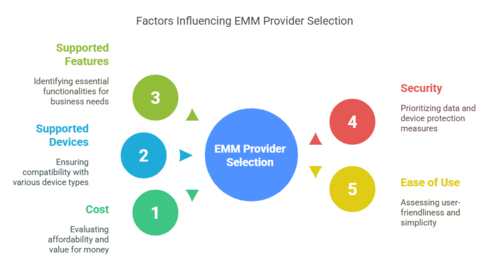
1Cost
While choosing an EMM solution for your business, thorough research must be done to make sure you get the best possible features for the most reasonable price. Do not fall for the overly advertised products and the features that you do not actually need. Striking a balance between a reasonable budget and the best value is the trick to get the best bargain.
Most of the vendors allow free access to their products for a limited time. Although these free trials in most cases do not give access to some premium features, these are enough to ascertain whether the solution is worth the cost.
2Supported Devices
Not all EMM solutions support all sorts of endpoint devices. Make sure your selected suite supports the type of devices you are using at your workplace. Consider going for the one that supports a broad range of devices so that if you plan to switch to include more types in the future, your EMM suite supports them. Moreover, don’t forget to check the OS version supported by the EMM suite.
3Supported Features
For some, cross-platform management might be the core required feature, while others might just need a program that offers enhanced security. Your goals define which EMM solution you should prefer. Hence, get an in-depth knowledge of the strengths of a particular EMM provider before selecting it.
4Security
Security is the foremost feature you should be concerned about while selecting an EMM plan. Ensure the plan offers features specifically targeted at securing your devices and data. For example, the features like geofencing, Kiosk, Identity and Access Management, password configuration, device lock, and data wipe in case of lost or stolen devices.
5Ease of Use
The user interface should be simple enough to allow easy navigation. Try free trials to make sure the EMM suite is not too complex to use and there is no learning curve.
5How to Set up Android EMM For Your Business?
Now that we have provided a quick breakdown of the various Android EMM providers, you can simply take your pick. Once you have picked your tool, it is time to set up the EMM tool for your business. Keep in mind that the setup and use procedures will vary depending on the Android EMM partners.
That said, here are the general steps to setup one:
Step 1 : Log in to EMM Console
Open AirDroid Business and enter your account. Then enter the password, and click Sign In.
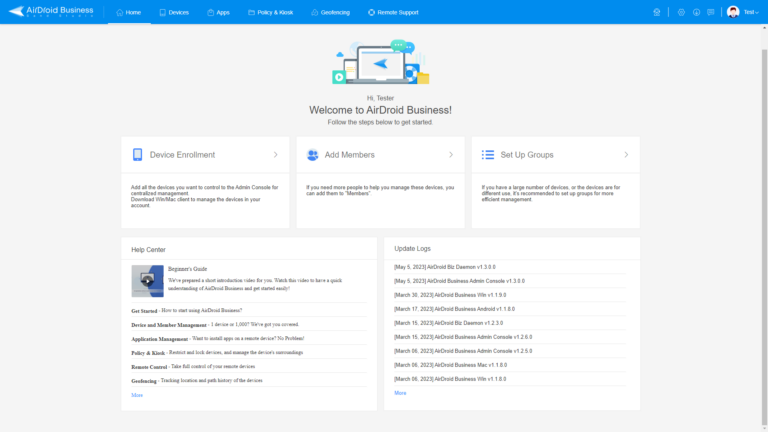
Step 2 : Enroll Android devices
Enroll the device via Android Enterprise Enrollment. Click on Devices > Device Enrollment > Android Enterprise Enrollment > Enrollment Guide.
Then, open the device camera and scan the QR code from Provisioning Templates. Click here to learn how to create.
Step 3 : Configure Device Settings and Apps
To configure device settings, go to Policy and create a config file. You can simply activate or turn off the corresponding buttons in the dashboard.
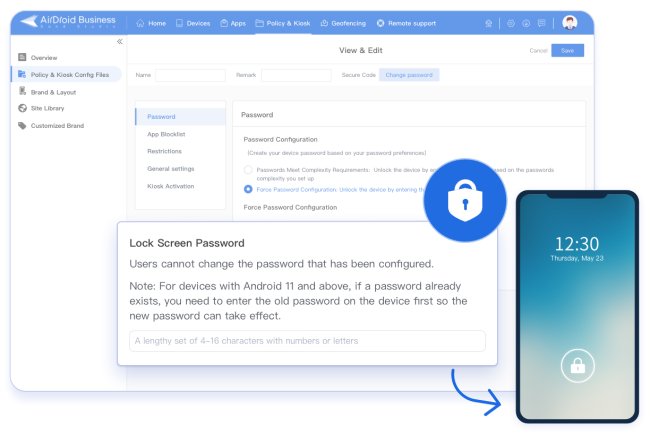
As for app configuration, you can open Apps > Apps Library > Managed Google Play Store. Click "+ Add App" to choose apps for work from Google.
After adding, tap the setting icon to complete the configuration. App Permission Management and App Update Management are available to control.
Step 4 : Invite Members and Divide into Groups
You can manually select your team members and send them an invite email. Then, you can assign different roles and permissions to your members. Now, you can manage devices with your team.
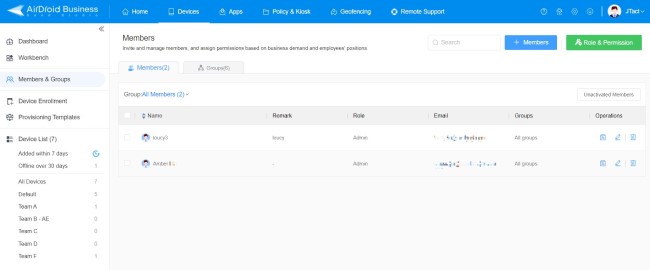
6Why do Businesses Apply Enterprise Mobility Management Android?
One of the main reasons businesses are increasingly adopting EMM solutions irrespective of their sizes is that they are concerned about the security of their devices and data. In an attempt to ensure workplace security and restrict unauthorized data, companies are adopting EMM solutions. Thanks to the stats that show a huge 58.2 % increase in phishing attacks in the year 2023, there is an ever increasing need for a comprehensive EMM plan at most of the workplaces.
Security is not the only reason for adopting EMM solutions world-wide. Many businesses are more interested in the enhanced productivity offered by EMM providers. The features like bulk file transfer, auto installing the required apps at the end point devices etc. Make it possible to enhance staff’s productivity by promptly providing them with the required resources.
You would be surprised to know that automation brought about by such EMM plans can help companies reduce costs by as much as 90%. This is a highly alluring benefit offered by EMM providers.
Conclusion
In short, EMM has revolutionized the way businesses operate around the globe. They offer multiple benefits including cost reduction, increased efficiency, and enhanced productivity. However, make sure you choose a plan that best suits your specific corporate needs so that you can get the best out of it.
FAQs







Leave a Reply.